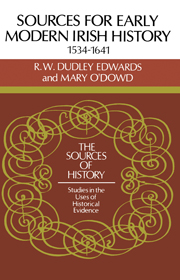Book contents
- Frontmatter
- Contents
- Acknowledgements
- Abbreviations
- Introduction
- 1 IRISH CIVIL CENTRAL ADMINISTRATION
- 2 IRISH CIVIL LOCAL ADMINISTRATION
- 3 ENGLISH AND OTHER CENTRAL ADMINISTRATIONS AND IRELAND
- 4 IRISH ECCLESIASTICAL ADMINISTRATION
- 5 CONTEMPORARY ACCOUNTS AND DESCRIPTIONS
- 6 MAPS AND DRAWINGS
- 7 ARCHIVAL COLLECTIONS
- 8 HISTORIOGRAPHY
- Index
4 - IRISH ECCLESIASTICAL ADMINISTRATION
Published online by Cambridge University Press: 08 January 2010
- Frontmatter
- Contents
- Acknowledgements
- Abbreviations
- Introduction
- 1 IRISH CIVIL CENTRAL ADMINISTRATION
- 2 IRISH CIVIL LOCAL ADMINISTRATION
- 3 ENGLISH AND OTHER CENTRAL ADMINISTRATIONS AND IRELAND
- 4 IRISH ECCLESIASTICAL ADMINISTRATION
- 5 CONTEMPORARY ACCOUNTS AND DESCRIPTIONS
- 6 MAPS AND DRAWINGS
- 7 ARCHIVAL COLLECTIONS
- 8 HISTORIOGRAPHY
- Index
Summary
The modern institutional history of the church in Ireland begins in the twelfth century with the establishment of the diocesan system in four provinces. From the coming of the Normans under Henry II the church was closely associated with the state and this continued until 1870 when the church of Ireland was disestablished. As the reformation and the English breach with Rome in the sixteenth century led to the splitting up of the church, the sources must be considered in the subdivisions of ‘church of Ireland’ and ‘Roman catholic’. In the seventeenth century presbyterianism brought into the country by Scots planters was organised as a third Christian church. No one since W. D. Killen, with the possible exception of Edward M. Eyre, has attempted to write the history of the church in Ireland as a single organisation. Yet the consciousness of the insularity of Ireland, which breaks through the writers, frequently reveals the reality of the institution in its similarities and differences from the church universal.
The continuity in the Irish church before and after the breach with Rome needs to be stressed. It is for this reason that this chapter begins with a short account of the church before the breach. It might also be noted that this chapter is concerned primarily with the documentation produced by the different organisations of the early modern churches. It is not concerned to document the religious practices of early modern Ireland which may not always be revealed in the ecclesiastical sources.
BEFORE THE BREACH
Institutionally, the church in Ireland was organised as elsewhere, the unit being the diocese whose ordinary official was the bishop or his vicar.
- Type
- Chapter
- Information
- Sources for Modern Irish History 1534–1641 , pp. 60 - 82Publisher: Cambridge University PressPrint publication year: 1985



